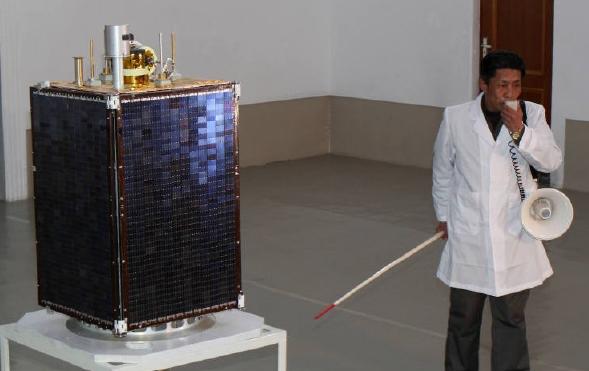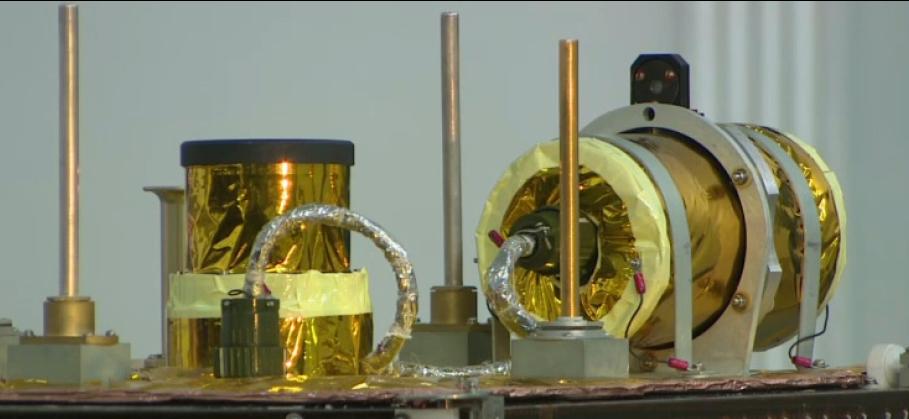There have been a lot of odd statements about North Korea’s satellite in the press over the last few days. I thought it would be useful to talk about some of them and try to clarify some misconceptions.
The Satellite
There is a lot of speculation about what the satellite might be and might do. While it’s true that we don’t know for sure what Pyongyang might have put on the front of their launcher, we do know what satellite North Korea showed international observers before the April launch—the Kawngmyongsong-3, or “Bright Star 3” satellite (Figure 1). North Korea has repeatedly said that last week’s launch carried a second copy of the same satellite. I haven’t seen any reason to doubt that—what they displayed seems to be about the right size and have the right parts—so it’s worth reminding ourselves what we learned in April.

Figure 1. North Korea’s Kawngmyongsong-1satellite being shown to international observers before the April 2012 launch.
What observers saw in April was a rectangular box roughly 2.5 ft square and 3.5 ft tall, said to weigh about 220 pounds (100 kg), and covered with solar panels that fold out in space to collect sunlight to power the instruments on the satellite. On the bottom is a round flange used to connect the satellite to the upper rocket stage (Figure 2). On the top are various antennas for communicating with the ground, a 10-cm diameter tube containing the camera lens (the gold cylinder with the black top to the left in the Figure 3), and another sensor of some type (to the right in Figure 3). The gold foil is intended to reflect sunlight to help keep the components cool. The use of the red electrical connectors and what looks like masking tape raises questions about the construction, or may indicate that this was not the final space-worthy satellite.
The silver cylinder on the far left in Figure 2 is thought to be a GPS navigation antenna that would allow the satellite to know its exact position and transmit that to the ground. The satellite does not appear to have any thrusters and therefore cannot maneuver in space. As a result, you would not expect it to carry fuel, contrary to reports that warned that it could spill toxic chemicals when it reenters the atmosphere.
There is a detailed analysis of the satellite, written by Nick Hansen at 38North.org, which appeared after its unveiling last April. Of its mission he writes:
“Its stated missions were for earth observation and transmission of scientific data when orbiting over the DPRK, and to transmit the hymns of Kim Il Sung and Kim Jong Il the rest of the time. The earth observation mission included monitoring forest resources and natural disasters, assisting in food crop planting and forecasting weather, all of which could be accomplished to some degree with the low-resolution video camera reported on the satellite.”
Playing songs from space has precedents: China’s first satellite in 1970 did nothing more than broadcast patriotic songs, in part to allow people on the ground to verify its presence. The first satellite, Spunik, broadcast a series of beeps for the same purpose.
Hansen estimates the resolution of the camera is “several 100 meters or greater, adequate for some civilian missions and of limited utility for the military.” North Korea told the observers the satellite had 3-axis stabilization, meaning it could control the satellite’s orientation in orbit, which would be used to point the camera and antennas at the earth. Hansen also notes that you can see an X-band antenna on the satellite, which allows rapid transmission of data from the camera to the ground. This is consistent with North Korea’s notification to the International Telecommunications Union (ITU) before the April launch, in which it stated that the satellite included an X-band radar.
“Tumbling Out of Control”
The U.S. announcement that the satellite may be tumbling has led to confusion. What that means is that the satellite may be rotating about its center of mass as it moves in orbit, preventing the North Koreans from sending it control signals and preventing the sensors on board the satellite from pointing at the earth. More on why that matters below.
A number of press sources seem to think that “tumbling out of control” means the satellite is careening randomly through space, and that South Korean reports that it is following a well-defined orbit with a well-defined speed refute the U.S. claim. They don’t. Once a satellite reaches space, its center of mass will follow an orbit that is determined by its initial speed, altitude, and direction. The body of the satellite may be rotating around its center of mass, but sensors tracking the satellite’s motion from the ground that are unable to detect that rotation would instead see the steady, predictable motion of the center of mass in its orbit. That motion indicates the satellite is in orbit but does not indicate anything about its rotation or its operation.
The well-defined and predictable motion of the satellite also means that it is unlikely to collide with other satellites, and that a close approach with another satellite would be known well in advance. And because they are in a relatively low altitude, the North Korean satellite and the few associated objects in orbit with it will experience relatively high atmospheric drag and will only stay in space for a couple of years before their orbits decay and they return to Earth.
Similarly, reports that “North Korean engineers aimed to put the satellite in a circular orbit, but that it’s now in an elliptical orbit” do not indicate a problem. The diameter of the satellite’s orbit is nearly 14,000 kilometers. So the small variation in the satellite’s altitude as it circles the earth (it ranges from 494 to 588 km) means that the orbit differs from a circle by less than 1%. That is considered a circular orbit. (This orbit has an eccentricity of 0.007, which is 20 times smaller than our definition of “elliptical orbit” in the UCS Satellite Database.)
The reason it matters if the satellite is rotating, or ‘tumbling,” is that if the satellite is not stabilized so that it can point its antennas at the earth, there is no way to communicate with it, either to monitor the health of its systems or to tell it what to do. Moreover, the other equipment and sensors on the satellite will not be useful if they cannot be pointed at the earth. For example, the on-board camera may be working, but if the satellite can’t point it at the earth it’s not very useful.
If the U.S. claim about the satellite is correct—and the U.S. has very good sensors to watch satellites, so I assume it is—it is still possible that over time North Korea can stabilize the satellite. If not, North Korea will have succeeded in getting its satellite into orbit, but will have missed the chance to try to operate it.


